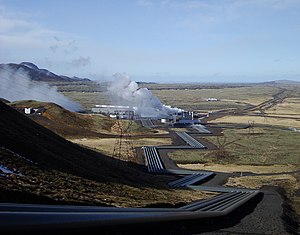Hellisheiði Power Station
This article's factual accuracy may be compromised due to out-of-date information. (April 2013) |
| Hellisheiði Power Station | |
|---|---|
 | |
 | |
| Country | Iceland |
| Location | Hengill |
| Coordinates | 64°02′14″N 21°24′03″W / 64.03722°N 21.40083°WCoordinates: 64°02′14″N 21°24′03″W / 64.03722°N 21.40083°W |
| Status | Operational |
| Commission date | 2006 |
| Owner(s) | ON Power |
| Geothermal power station | |
| Type | Flash steam |
| Wells | 50 |
| Max. well depth | 2,200 m (7,200 ft) |
| Cogeneration? | Yes |
| Thermal capacity | 133 MWt |
| Power generation | |
| Units operational | 6 x 45 MW 1 x 33 MW |
| Nameplate capacity | 303 MW |
| External links | |
| Website | www |
| Commons | Related media on Commons |
The Hellisheiði Power Station (Icelandic pronunciation: [ˈhɛtlɪsˌheiːðɪ]; HGPS) is the third-largest geothermal power station in the world.[1] The facility is located in Hengill, southwest Iceland, 11 km (7 mi) from the Nesjavellir Geothermal Power Station. The plant has a capacity of 303 MW of electricity and 133 MWth of hot water[2] for Reykjavik's district heating.[3] HGPS is owned and operated by ON Power, a subsidiary of Reykjavík Energy.
History[]

Electricity production with two 45 MW turbines commenced in 2006. In 2007, an additional low pressure steam turbine of 33 MW was added. In 2008, two 45 MW turbines were added with steam from Skarðsmýrarfjall Mountain. The hot water plant was introduced in 2010 and the last two high pressure 45 MW turbines were added in 2011. In order to reduce hydrogen sulphide pollution in the capital area a system was added to the plant in 2014 which reinjects non-condensable gases into the ground.[4]
Features[]

The power plant offers educational tours and presentations about sustainable energy as part of its Geothermal Energy Exhibition.[5]
A pilot direct air capture facility operated by Climeworks is co-located at this site. It was funded by the European Union's Horizon 2020 program, and captures 50 metric tons of carbon dioxide each year. The carbon dioxide is captured, injected into the ground, and mineralized.[6][7][8]
See also[]
| Wikimedia Commons has media related to Hellisheiði Geothermal Plant. |
- Geothermal power in Iceland
- List of largest power stations in the world
- List of power stations in Iceland
- Renewable energy in Iceland
- CarbFix
References[]
- ^ "Hellisheidarvirkjun heat and power station in South Iceland". Extreme Iceland. Retrieved 2013-04-02.[unreliable source?]
- ^ "Hellisheidi Geothermal Power Plant Engineers - Mannvit - Mannvit". Mannvit. Archived from the original on 2009-05-30. Retrieved 2010-01-02.
- ^ "Sustainable energy: inside Iceland's geothermal power plant". the Guardian. 29 May 2016. Retrieved 8 September 2016.
- ^ "Mengun dælt í iður jarðar". 8 October 2014.
- ^ "The Geothermal Energy Exhibition". Retrieved 9 November 2015.
- ^ "Climeworks and CarbFix2: The world's first carbon removal solution through direct air capture | Climeworks – Capturing CO2 from Air" (in British English). Retrieved 2019-12-22.
- ^ Rathi, Akshat. "World's first "negative emissions" plant turns carbon dioxide into stone". Quartz. Retrieved 2019-12-22.
- ^ "Plans to double CarbFix reinjection at the Hengill Geothermal Area". Carbfix. 2019-11-20. Retrieved 2019-12-24.
{{cite web}}: CS1 maint: url-status (link)
External links[]
- Official website
- Hellisheiði Power Plant 2006-10-21 - Picture gallery from islandsmyndir.is
- Hellisheiði Power Plant 2008-11-15 - Picture gallery from islandsmyndir.is
- Hellisheiði Power Plant 2009-10-04 - Picture gallery from islandsmyndir.is
- Hellisheiði Power Plant, Inside 2012-04-27 - Picture gallery from islandsmyndir.is
- Hellisheiði Power Plant, Outside 2012-05-09 - Picture gallery from islandsmyndir.is
- Geothermal power stations in Iceland
